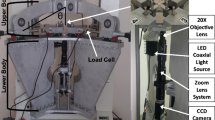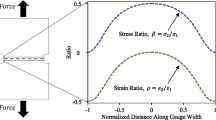Abstract
In this study, we obtain true stress–strain (SS) curves for a sheet specimen under consideration of local necking and material anisotropy. We first extract the SS curve up to the diffuse necking point from the tensile test load–displacement data. The curve’s part after the onset of diffuse necking is extrapolated by the weighted-average method proposed by Ling [Y. Ling, AMP J. Technol. 5, 37–48 (1996)]. Initiation of local necking is predicted by means of the minor-to-major strain ratio in the specimen’s center. We propose a criterion to determine the strain ratio at the onset of local necking and the major strain corresponding to the strain ratio at local necking. We complete the true SS curve by cutting off the SS curve at the major strains corresponding to the local necking or apparent fracture point. Finally, the effects of material anisotropy on SS curves are discussed.
















Similar content being viewed by others
References
J.D. Bressan and R.K. Unfer: Construction and validation tests of a torsion test machine. J. Mater. Process. Technol. 179, 23–29 (2006).
E.E. Cabezas and D.J. Celentano: Experimental and numerical analysis of the tensile test using sheet specimens. Finite Elem. Anal. Des. 40, 555–575 (2004).
S. Dumoulin, L. Tabourot, C. Chappuis, P. Vacher, and R. Arrieux: Determination of the equivalent stress-equivalent strain relationship of a copper sample under tensile loading. J. Mater. Process. Technol. 133, 79–83 (2003).
J.C. Gelin and O. Ghouati: The inverse approach for the determination of constitutive equations in metal forming. Ann. CIRP 44, 189–192 (1995).
N. Huber and C. Tsakmakis: Determination of constitutive properties from spherical indentation data using neural networks. Part II: Plasticity with nonlinear isotropic and kinematic hardening. J. Mech. Phys. Solids 47, 1589–1607 (1999).
H. Lee, J.H. Lee, and G.M. Pharr: A numerical approach to spherical indentation techniques for material property evaluation. J. Mech. Phys. Solids 53, 2037–2069 (2005).
G. Mirone: A new model for the elastoplastic characterization and the stress-strain deformation on the necking section of a tensile specimen. Int. J. Solids Struct. 41, 3545–3564 (2004).
H.C. Hyun, J.H. Lee, and H. Lee: Mathematical expressions for stress-strain curve of metallic material. Trans. KSME 32, 21–28 (2008).
P.W. Bridgman: Studies in Large Plastic Flow and Fracture (McGraw Hill Book Company Inc., New York, 1952).
M.S. Joun, I.S. Choi, J.G. Eom, and M.C. Lee: Finite element analysis of tensile testing with emphasis on necking. Comput. Mater. Sci. 41, 63–69 (2007).
M.S. Joun, J.G. Eom, and M.C. Lee: A new method for acquiring true stress-strain curves over a large range of strains using a tensile test and finite element method. Mech. Mater. 40, 586–593 (2008).
Y. Ling: Uniaxial true stress-strain after necking. AMP J. Technol. 5, 37–48 (1996).
H. Tao, N. Zhang, and W. Tong: An iterative procedure for determining effective stress-strain curves of sheet metals. Int. J. Mech. Mater. Des. 5, 13–27 (2009).
K.S. Zhang and Z.H. Li: Numerical analysis of the stress-strain curve and fracture initiation for ductile material. Eng. Fract. Mech. 49, 235–241 (1994).
N. Tardif and S. Kyriakides: Determination of anisotropy and material hardening for aluminum sheet metal. Int. J. Solids Struct. 49, 3496–3506 (2012).
Z.L. Zhang, M. Hauge, J. Odegard, and C. Thaulow: Determining material true stress-strain curve from tensile specimens with rectangular cross-section. Int. J. Solids Struct. 36, 3497–3516 (1999).
I. Scheider, W. Brocks, and A. Cornec: Procedure for the determination of true stress-strain curves from tensile tests with rectangular cross-section specimens. ASME J. Eng. Mater. Technol. 126, 70–76 (2004).
H.C. Hyun, M. Kim, H. Lee, and N. Kim: Sectional FE forming limit models of Zircaloy-4 and Zirlo sheets for stamping process of spacer grids of nuclear fuel rods (2014, in preparation).
H.C. Hyun, M. Kim, H. Lee, and N. Kim: Dependency of forming limit stress diagram on yield criterion in Zircaloy-4 and Zirlo Sheets (2014, in preparation).
ABAQUS User’s Manual, 2010. Version 6.10 (Dassault Systemes Simulia Corp., Providence, RI).
A.L. Gurson: Continuum theory of ductile rupture by void nucleation and growth: Part-1: Yield criteria and flow rules for porous ductile media. J. Eng. Mater. Technol. 99, 2–15 (1977).
V. Tvergaard and A. Needleman: Analysis of the cup-cone fracture in a round tensile bar. Acta Metall. 32, 157–169 (1984).
Z.L. Zhang, J. Ødegard, O.P. Sovik, and C. Thaulow: A study on determining true stress–strain curve for anisotropic materials with rectangular tensile bars. Int. J. Solids Struct. 38, 4489–4505 (2001).
R. Hill: On discontinuous plastic state, with special reference to localized necking in thin sheets. J. Mech. Phys. Solids 1, 19–30 (1952).
ACKNOWLEDGMENTS
This work was supported by the National Research Foundation of Korea (NRF) grant funded by the Korea government (MEST) (No. NRF-2012 R1A2A2A 01046480).
Author information
Authors and Affiliations
Corresponding author
Rights and permissions
About this article
Cite this article
Hyun, H.C., Kim, M., Bang, S. et al. On acquiring true stress–strain curves for sheet specimens using tensile test and FE analysis based on a local necking criterion. Journal of Materials Research 29, 695–707 (2014). https://doi.org/10.1557/jmr.2014.24
Received:
Accepted:
Published:
Issue Date:
DOI: https://doi.org/10.1557/jmr.2014.24




